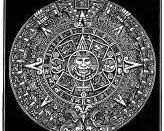Aztecs, and their sacrifices
In the early summer of 1521, sixty-two of the Spanish army's companions had been captured, and Cortes and the other survivors helplessly watched one of the men were being taken a mile away across the water on one of the major temple-pyramids of the city in the middle of the lake. Drums sounded, Trumpet like instruments were played. Witnesses said it was a terrifying sound. They watched their men being dragged up the steps of the tall pyramids from a far, helpless to do anything. They placed them on a platform in front of the shrine of their fake gods. They placed plumes on their heads and made them dance. After the dance was finished, the Indians placed them on their backs, cut open their chests, and offered their still beating hearts to their idols...
This was the only time this ritual was witnessed by Europeans, shortly after the Spanish took over the Aztec empire.
Ever since then, the exact number of sacrifices made is unknown. 20,000 a year is a common estimate.
Scientist can only guess why these sacrifices were made. Once guess is that the Aztec religion required the sacrifices, basically their gods demanded them, frequently as well. Although this explanation doesn't suggest why this form of religion was formed and when.
Another question that comes up is, if these many sacrifices were made, then what did they do with the bodies after wards? Nothing really tells. Books from the twentieth century barely mention the topic, while others skip it all together. Some think that the victims were eaten, making the Aztecs cannibals. But according to some early accounts, some victims were not eaten, such as children drowned for the rain god, or people suffering skin diseases. A principal and even sometimes an objective...



My thoughts
I think that this essay is hard to take seriously as it contains lapses in grammar, and espexially when the title is spelt wrong. However some relevant information when the grammatical errors are put aside. Could be improved by a neat conclusion summing up all the arguments and line of discussion
3 out of 3 people found this comment useful.